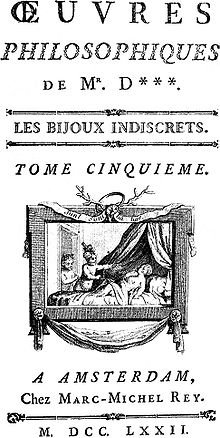The Indiscreet Jewels (or The Indiscreet Toys, or The Talking Jewels; French: Les Bijoux indiscrets) is the first novel by Denis Diderot, published anonymously in 1748. It is an allegory that portrays Louis XV of France as Mangogul, Sultan of Congo, who owns a magic ring that makes women's vaginas ("jewels") talk. The character of Mirzoza represents Louis XV's mistress Madame de Pompadour.[1] Diderot portrayed Pompadour in a flattering light in The Indiscreet Jewels, most likely to ensure her support for his Encyclopedie.[2]
 | |
| Author | Denis Diderot |
|---|---|
| Original title | Les Bijoux indiscrets |
| Country | France |
| Language | French |
Publication date | 1748 |
Plot summary edit
Sultan Mangogul of Congo is bored with life at court and suspects his mistress Mirzoza of infidelity. A genie presents him with a magical ring that has unique properties. When the ring is rubbed and pointed at the vagina of any woman the vagina begins speaking about its amorous experiences, to the confusion and consternation of its owner.[3][4][note 1] The Sultan uses the ring about thirty times, usually at a dinner or other social gathering, and on these occasions the Sultan is typically visible to the woman.[5][6] However, since the ring has the additional property of making its owner invisible when required, a few of the sexual experiences are recounted through direct observation, as the Sultan makes himself invisible in the unsuspecting woman's boudoir.[5]
Notes edit
English translations edit
- From Their Lips to His Ear. Pocket Erotica Series #6 (New Urge Editions/Black Scat Books, ISBN 978-1735615912, 2020)
References edit
- ^ Mystifying the Monarch: Studies on Discourse, Power, and History. Deploige, Jeroen., Deneckere, Gita, 1964-. [Amsterdam]: Amsterdam University Press. 2006. ISBN 9789053567678. OCLC 85838955.
{{cite book}}: CS1 maint: others (link) - ^ de La Harpe, Jean François. Lycée, ou Cours de littérature ancienne et moderne: Tome 2. Paris: Et. Ledoux et Tenré. p. 371.
- ^ Otis Fellows (1977). Diderot. Alfred A. Knopf. p. 44.
- ^ a b P.N. Furbank (1992). Diderot:A Critical Biography. Twayne. p. 44.
- ^ a b Suzanne Rodin Pucci (1990). The Discreet Charms of the Exotic: Fictions of the Harem in Eighteenth-Century France in Exoticism in the Enlightenment (ed. George Sebastian Rousseau and Roy Porter). Manchester University Press. p. 156.
- ^ Will Durant (1965). The Story of Civilization Volume 9:The Age of Voltaire. Simon&Schuster. p. 627.
Links edit
- Les bijoux indiscrets, tome premier (French) from Google Books
- Les Bijoux Indiscrets: or, The Indiscreet Toys, volume I (English) from Google Books